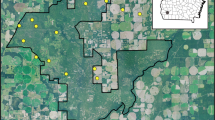Abstract
Waterfowl pair and brood use of constructed wetlands was evaluated during 1980–81 on 4 Wildlife Management Areas in northwestern Minnesota. Weekly ground counts of waterfowl were made at each of 109 wetlands during the April to mid-July nesting season and correlated with physical, vegetative, and limnological characteristics. The number of pairs of the 10 most common waterfowl species using the wetlands was 338 in 1980 and 239 in 1981, of which blue-winged teal (Anas discors) made up nearly half. Ducks used the constructed wetlands primarily during late May and early June. Eighteen habitat components were significantly correlated with pair numbers of 1 or more duck species. Wetlands with larger surface area and longer shoreline length had greater pair use, by every duck species except gadwall (Anas strepera). Other physical parameters correlated with duck use included distance to nearby large impoundments, wetland density, and distance to nearest constructed wetland.
Similar content being viewed by others
Literature Cited
Dwyer, T. J. 1970. Waterfowl breeding habitat in agricultural and nonagricultural land in Manitoba. Journal of Wildlife Management 34:130–136.
Dzubin, A. 1955. Some evidence of home range in waterfowl. Transactions North American Wildlife Conference 20:273–298.
Eggers, S. D. and D. M. Reed. 1987. Wetland plants and plant communities of Minnesota and Wisconsin. U.S. Army Corps of Engineers. St. Paul, MN, USA.
Evans, C. D. and K. E. Black. 1956. Duck production on the prairie potholes of South Dakota. U.S. Fish and Wildlife Service Special Scientific Report, Wildlife No. 32. Washington, DC, USA.
Gilmer, D. S., I. J. Ball, L. M. Cowardin, J. H. Riechmann, and J. R. Tester, 1975. Habitat use and home range of mallards breeding in Minnesota. Journal of Wildlife Management 39:781–789.
Hammond, M. C. 1969. Notes on conducting waterfowl breeding population surveys in the north central states. p. 238–254.In Saskatoon Wetlands Seminar. Canadian Wildlife Service, Report Series 6, Ottawa, Ontario, Canada.
Hammond, M. C. and C. H. Lacy. 1959. Artificial potholes and ditches as waterfowl habitat. Unpublished manuscript presented at Midwest Wildlife Conference 21, Minneapolis, MN, USA.
Heinselman, M. L. 1963. Forest sites, bog processes, and peatland types in the Glacial Lake Agassiz region. Minnesota. Ecological Monographs 33:327–374.
Joyner, D. E. 1980. Influence of invertebrates on pond selection by ducks in Ontario. Journal of Wildlife Management 38:408–417.
Leschisin, D. A. 1982. Waterfowl use of dug ponds in northwestern Minnesota. M.S. Thesis. University of Minnesota, St. Paul, MN, USA.
Linde, A. F. 1969. Techniques for wetland management. Wisconsin Department of Natural Resources Technical Bulletin 94. Madison, WI, USA.
Linde, A. F., T. Janish, and D. Smith. 1976. Cattail—the significance of its growth phenology, and carbohydrate storage to its control and management. Wisconsin Department of Natural Resources Technical Bulletin 94. Madison, WI, USA.
Lokemoen, J. T. 1973. Waterfowl production on stock-watering ponds in the northern plains. Journal of Range Management 26: 179–184.
McKinney, F. 1965. Spacing and chasing in breeding ducks. Annual Report Wildfowl Trust 16:92–106.
Mendall, H. 1958. The ring-necked duck in the northeast. University of Maine Bulletin 16. Orono, ME, USA.
Parker, J. M., K. R. Hennings, and J. L. Hansen. 1980. Thief Lake Wildlife Management Area Master Plan, 1980–1989. Minnesota Department of Natural Resources. St. Paul, MN, USA.
Poston, H. J. 1974. Home range and breeding biology of the shoveler. Canadian Wildlife Service Report Series 25, Ottawa, Ontario, Canada.
U.S. Department of Agriculture. 1977. General soil map of Marshall County, Minnesota. USDA-SCS, Lincoln, NE, USA.
Weisberg, S. 1980. Applied Linear Regression. Wiley and Sons, New York, NY, USA.
Weisberg, S. 1981. MULTREG users manual University of Minnesota, St. Paul, MN, USA.
Wheeler, W. E. and J. R. March, 1979. Characteristics of scattered wetlands in relation to duck production in southeastern Wisconsin. Wisconsin Department of Natural Resources Technical Bulletin 116, Madison, WI, USA.
Author information
Authors and Affiliations
Rights and permissions
About this article
Cite this article
Leschisin, D.A., Williams, G.L. & Weller, M.W. Factors affecting waterfowl use of constructed wetlands in northwestern Minnesota. Wetlands 12, 178–183 (1992). https://doi.org/10.1007/BF03160607
Received:
Revised:
Accepted:
Issue Date:
DOI: https://doi.org/10.1007/BF03160607




